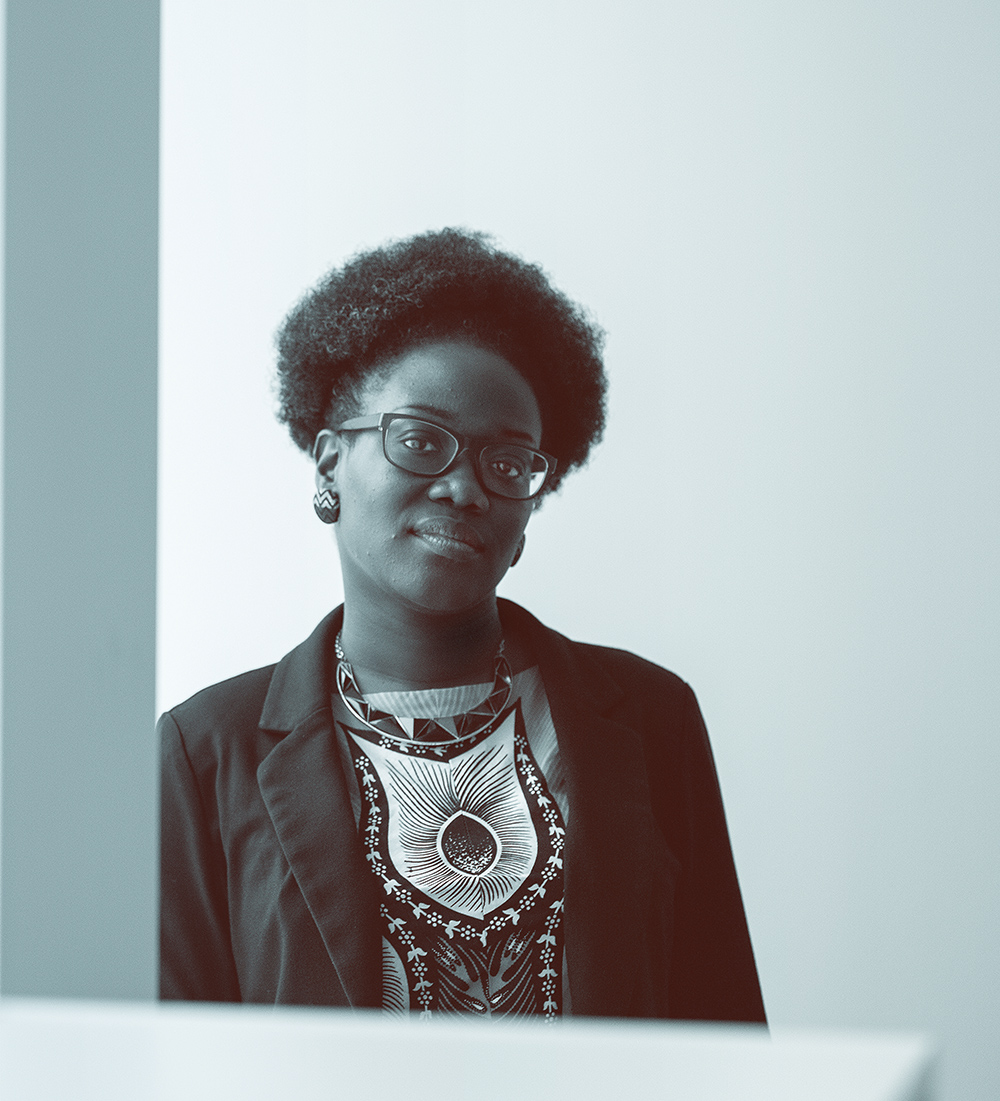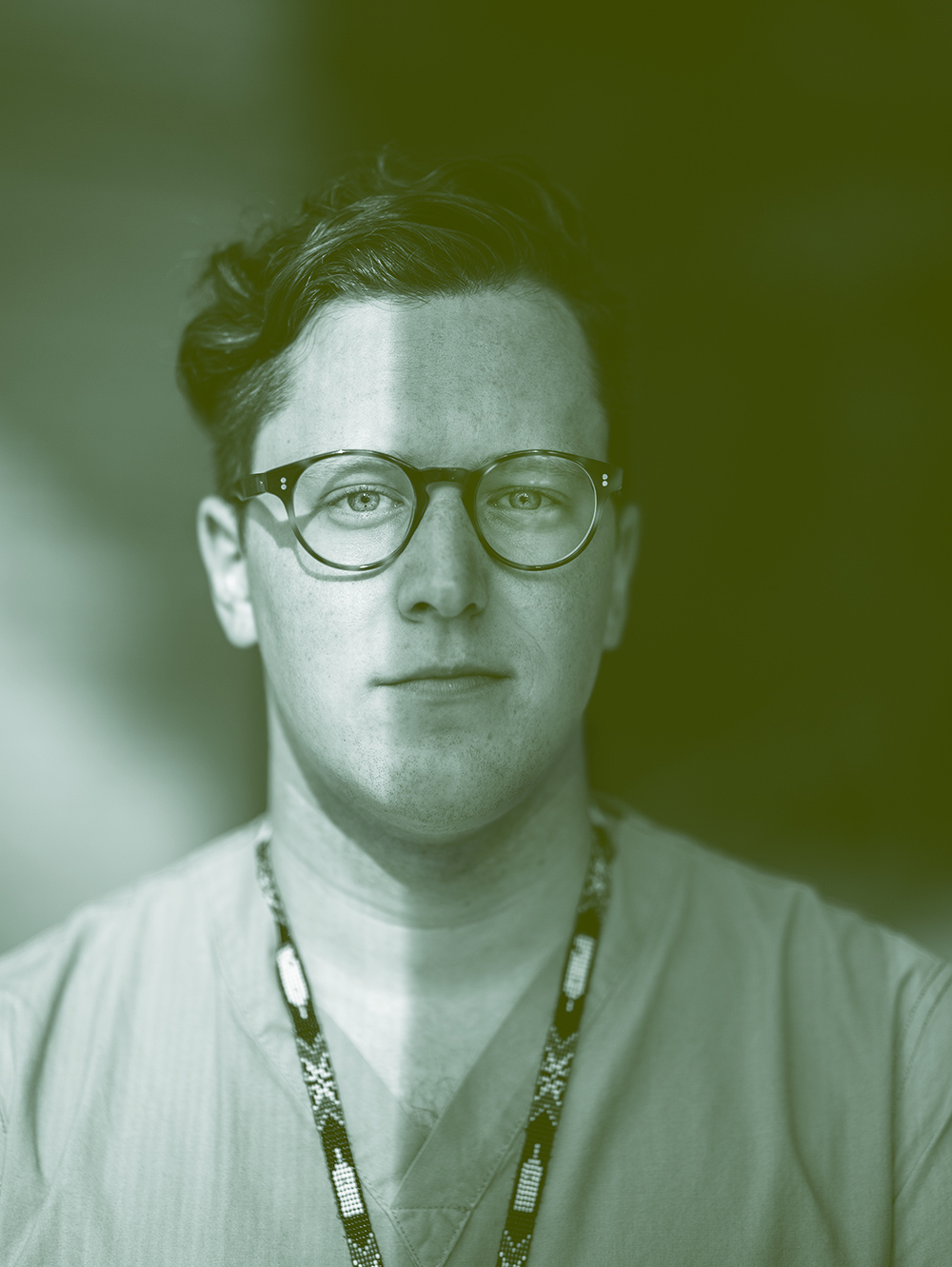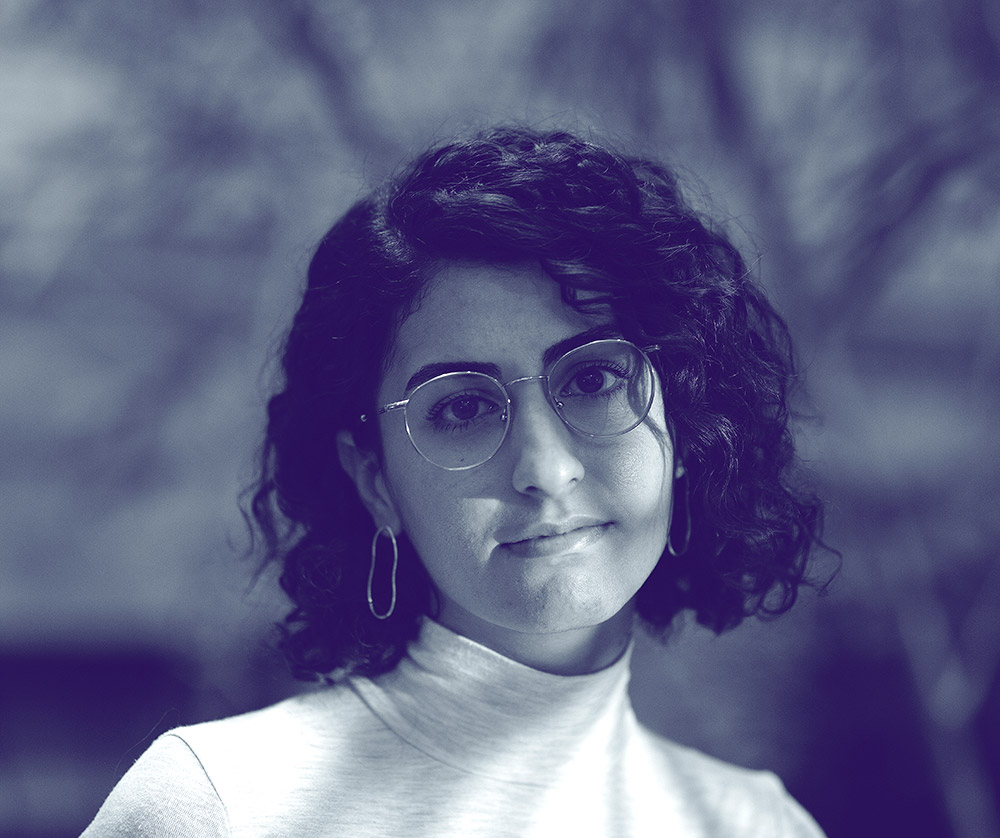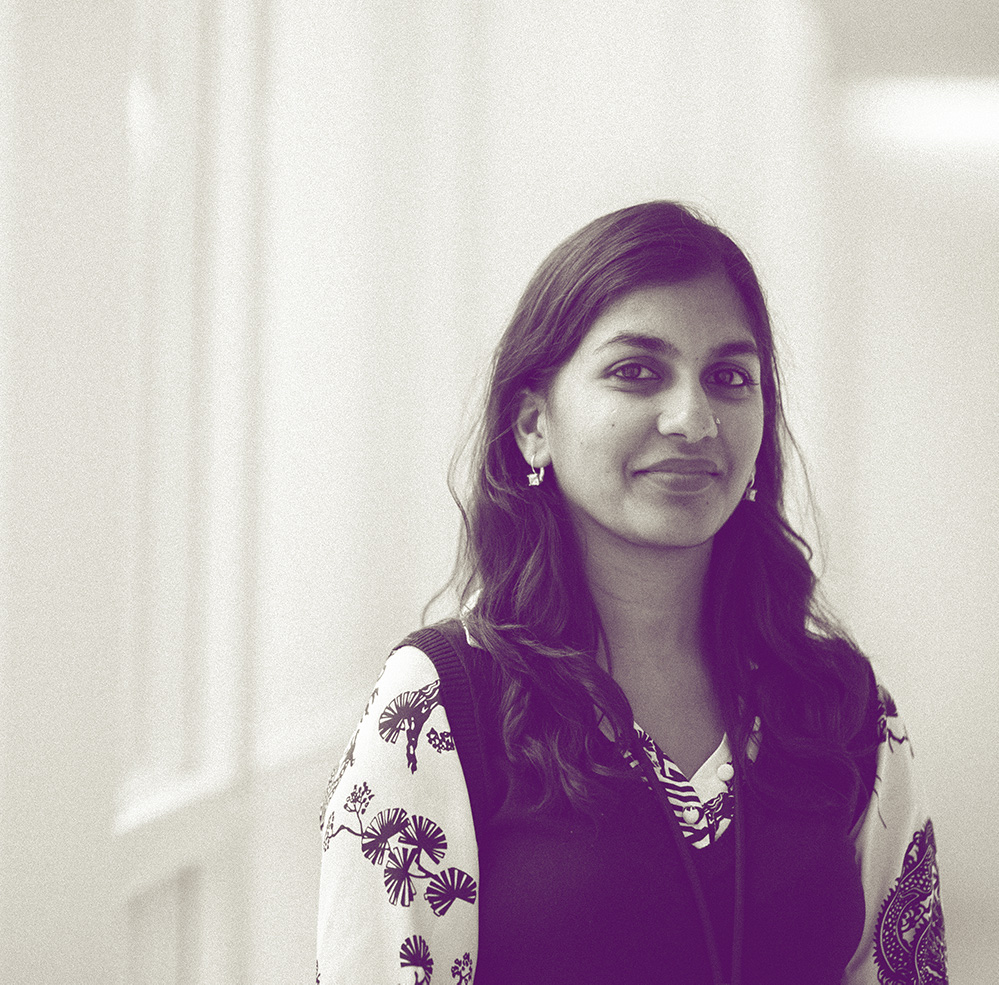Power Shift
Advocacy
from the
Margins
By Jim Oldfield
“What’s going on at U of T?”
Diane Smylie (MSW ’94), director of the Ontario Indigenous Cultural Safety Program, was on the phone this spring with Professor Lisa Richardson [PGME ’05 (Internal Medicine), PGME ’08], an internist who co-leads the Office of Indigenous Medical Education at the University of Toronto.
Richardson was surprised by the question, and concerned. “I thought, ‘Oh boy, this could really go either way,’ ” she says, recalling her growing unease at the time.
But the news was good. Smylie had spoken with Kathy Loon, manager of traditional programs at Sioux Lookout Meno Ya Win Health Centre, which serves a broad population in northwestern Ontario that includes 28 First Nations.
Loon was impressed with the U of T medical students and residents on placements at the centre, and had noticed a spike in their referrals to Indigenous elders. Some were attending Indigenous ceremonies and taking a more holistic approach to healing.
“From an educator’s perspective, that’s what we aim for,” says Richardson, an associate professor in U of T’s Department of Medicine. “It shows a change in practice. To hear that unsolicited from an Indigenous leader in a northern hospital was remarkable, and it inspired me to keep doing this work.”
This work,’ for Richardson, involves the recruitment and support of Indigenous trainees, and making curriculum changes in the MD Program to increase awareness among all medical students of Indigenous issues.
But it includes a surge of activity from other faculty, staff and students to confront power disparities across the Faculty of Medicine and in health care practice: application pathways for Black and Indigenous medical school applicants based on rigorous GPA and MCAT scores but also life experiences; supports for economically disadvantaged students; a preclerkship curriculum, now in its third year, focused on patient-centred care and physician wellness; faculty development to address unconscious bias; and ambitious partnerships with Toronto’s teaching hospitals to reduce bullying, harassment and discrimination.
The goal is systemic change, the uprooting of a medical culture long reliant on hierarchy and tethered to notions of scientific objectivity and cultural neutrality that too often blind physicians to racism and other social factors that influence health. Advocacy from the margins has led to progress for women, racial and gender minorities, and more recently for people with disabilities and low socio-economic status, among others.
But some education scholars and others say there is much more to do, and that the latest language of equity, diversity and inclusion — omnipresent in medical schools today — may hinder progress as much as it helps. The move to democratize power in medicine may fall short of its aims.
“Experts at the centres of power have called for new ways of teaching and practice for decades, and yet systemic inequities persist,” says Professor Lisa Robinson [MD ’91, PGME ’92 (Internal Medicine)], a paediatric nephrologist and cell biologist who is associate dean of inclusion and diversity for the Faculty of Medicine. “At the same time, we’ve seen many meaningful moves toward equity. The question is whether 10 years from now we’ll look back and say, ‘Wow, things really have changed.’ ”

Professor Onye Nnorom
New Pathways for Students
A striking recent example of change is the number of Black medical students at U of T. In 2016, the first-year class had one Black student; last year the medical school admitted 14 and this year 15. The jump is due largely to a new Black student application program, known as BSAP.
“BSAP has been a game changer,” says Professor Onye Nnorom (MPH ’11), a family physician, public health specialist and Black Health Theme lead for the MD Program. The BSAP stream is optional but requires that applicants write a personal essay, and that members of the Black community review files and attend admission interviews. Applicants must meet the same academic standards as all other students, and there is no admissions quota.
And, these students are doing well. Community groups such as the Black Physicians’ Association of Ontario and Black Health Alliance, which first expressed skepticism about BSAP, have helped support the program and its students. Formal and informal feedback from students suggests that most feel included, despite a few reports of micro-aggressions, mostly in clinical settings. “On the whole, they are happy to be here and excited to be part of a culture change,” Nnorom says.
A similar admissions stream for Indigenous students has also altered the makeup of the student body. Eighteen Indigenous students have entered the medical school since the launch of the Indigenous student application program in 2012. One is Ryan Giroux (MD ’17), who is Métis from rural Alberta and is now a third-year paediatrics resident at The Hospital for Sick Children.
Giroux’s contributions underscore the value that diverse students can bring to medical schools. He has advocated nationally for more Indigenous and LGBTQ2S content in medical curricula, and co-leads qualitative research on resident experiences and intersectionality, or how the identities of marginalized groups overlap in individuals.
As a second-year student in 2014, Giroux questioned an established professor’s view on the high-profile case of J.J., a Six Nations child whose family withdrew her from cancer treatment and sought alternative healing. “I was rather dismissive of the family’s decision,” recalls Philip Hébert, then a professor of family and community medicine at U of T and author of Doing Right, a 1996 bestseller on medical ethics. “I made an offhand remark in class, something like,
‘I would never let my child do that.’ ”
Giroux was bothered by the certainty of Hébert’s view and its potential to sway other medical students, and he struggled for days with whether to speak up, worried that doing so might jeopardize his reputation and a residency in family medicine.
He eventually voiced his concern with the Faculty administration. The Dean proved supportive, as was Hébert, who later asked Giroux to edit chapters of a book he was writing. “Ryan was right to question me,” says Hébert. “I became more open to other ways of coping with illness, and the experience changed my perspective and how I taught.”

Paediatrics Resident Ryan Giroux
Organizational Change
A growing body of research shows that a diversity of views makes organizations better. Medical schools have embraced this idea in the last decade, moving away from the rhetoric of social responsibility to espouse the benefits of diversity and inclusion for research innovation and entrepreneurism, problem solving, more person-centred care and a reduction in health inequities.
The Faculty of Medicine took a historic step in that direction in January, with the inclusion of ‘excellence through equity’ as one of three pillars in its academic strategic plan. “It’s an idea that’s long overdue,” says Stephanie Nixon (MSc ’00, PhD ’06), an associate professor of physical therapy at U of T who helped draft the plan. “And its explicit framing in the plan is exciting because it suggests we’re taking it seriously. Equity isn’t just something we should do because it’s fair. No, we are all diminished by excluding the talents and innovation of marginalized groups.”
Confronting systemic inequities requires the expertise of those who embody the experience of oppression, and they should lead that work
The plan has spurred new administrative efforts to improve equity. A working group on equity, diversity and inclusion (EDI) has completed an environmental scan, mapped existing and potential partnerships and studied successful educational campaigns. Faculty administrators are discussing a new centre for research and education on equity, and half of the Faculty’s 26 academic departments have appointed EDI representatives.
These changes follow creation of an office of inclusion and diversity in 2017. The office runs a diversity mentorship program that pairs students with faculty mentors, and it helps support two longer-running programs that have helped boost the number of health professionals from underrepresented groups in medicine, although not all in Toronto. A program called ‘community of support’ has placed 140 students in North American medical schools since 2015, and a summer mentorship program has for 25 years offered exposure to the health sciences for underprivileged high school students.
Members of historically marginalized groups now lead many of these efforts — a key change. “For a long time, work in this area was done ‘on behalf of’ by those in positions of privilege; that is, unearned advantage people receive because they are white, straight, male, middle class and so forth,” says Nixon. “But confronting systemic inequities requires the expertise of those who embody the experience of oppression, and they should lead that work.”
Allowing and enabling that work can demand a shift in thinking about leadership; good leaders are often good listeners and followers. But it also requires the continued recruitment of faculty, staff and students who have experienced disadvantage and discrimination, and who understand the impact of privilege on health.
Criteria in MD Admissions
It’s not easy to choose medical students who will become compassionate doctors. Medical schools are flooded with strong applications; more than 3,500 candidates apply to the MD Program at U of T each year, for just 259 spots.
Moreover, the non-academic qualities that help make a great doctor can be tough to gauge. “It’s not all about being smart,” says Professor David Latter, a cardiac surgeon and director of MD admissions and student finances at U of T.
“We also want students with the character the public expects in a doctor, i.e., hard-working, can communicate, has empathy and a sense of social justice. It’s hard to find students with the best of those qualities.”
To better capture those ideal students, U of T’s medical school is tweaking the admissions process and will roll out three changes in this year’s admissions cycle. The MCAT assessment, which previously required a score of 125 in each of four sections, will soon allow one score of 124. Latter says this shift is small but significant and addresses a long-standing problem: “Many students fell just short in one category. That bothered us because some of them had achieved a lot and had compelling personal stories.”
The MCAT change helps level the socio-economic playing field because it recognizes that some students have much more time and money to prepare for the test than others. The school has likewise standardized the format of reference letters and will change how it scores them, in part because letters are often better for students from privileged backgrounds, and research shows they do not correlate well with success in medical school.
Admission interviews are another key area of change. The school now weights them more heavily, and about four years ago moved from a panel format to multiple personal interviews, which allow interviewers to learn more about candidates. Since 2017, the school’s roughly 220 interviewers have received unconscious bias training and regular monitoring to help them limit variations in their scores that may be linked to race, gender and other factors.
Other changes are in the works, including online video interviewing to limit the financial impact on applicants. “We’re doing OK,” says Latter. “We have a lot of phenomenal young people here, but you don’t change institutional structures and attitudes overnight.”
A New Kind of Physician
The idea of the ‘good doctor’ who provides empathetic care to all patients has been a goal of medical educators for decades. That ideal is codified in CanMEDS, the competencies laid out by the Royal College of Physicians and Surgeons of Canada that include communicator, collaborator and health advocate in addition to medical expert.
But medical schools have struggled to integrate those roles into curricula. “Many of the CanMEDS roles are patient-centred and rooted in social science, but for years we weren’t teaching them that way,” says Ayelet Kuper [MD ’01, PGME ’06, PGME ’07 (CEP), MEd ’07], an associate professor of medicine at U of T and a scientist at the Wilson Centre, which puts an interdisciplinary lens to the study of health professions education.
Research by Kuper and many other education scholars helped inform a curriculum overhaul at U of T, and in 2015 the medical school launched a new pre-clerkship that significantly changed the first two years of classroom-based training.
The Foundations curriculum, as the school called it, brought in considerable learning from the social sciences and humanities to complement rapidly evolving biomedical content. It also included specific and historical material on oppression to encourage students to reflect on their decision-making and develop a broad social conscience.
Three themes lay at the heart of this new content, says Kuper: culture, justice and power, linked with a contemporary understanding of how we create knowledge and interact with each other.
“It’s not enough to tell students to advocate, collaborate nicely and be professional with patients,” she says. “We need to show them how power works and model ways of addressing it, so they see that understanding privilege is a core part of being a physician.”

MD student Maryam Golafshani
Teaching Today’s Students
Student feedback on the curriculum has been positive and constructive, says Marcus Law [HBSc ’96, MD ’00, PGME ’02 (Family Medicine), MEd ’13], a professor of family and community medicine and director of Foundations. He and others are compiling long-term data that will provide insight into how specific content has landed with students, but some preliminary results are in.
Professor James Owen worked with a family medicine resident, Kira Abelsohn, who surveyed and compared pre- and post-Foundations students on their readiness to care for members of the LGBTQ2S community. Owen, the LGBTQ2S Education Theme lead for the MD Program, says early analysis shows Foundations students were significantly more knowledgeable and felt better prepared to provide culturally sensitive care.
At the same time, Owen notes, a student group advocating for more anti-oppression and social justice content has approached him and other faculty. “It’s been interesting to think that we have come quite far with the Foundations curriculum, yet students continue to push us forward,” he says.
One such student is Maryam Golafshani, who studied literature and theory at Western University and is now a first-year medical student. Golafshani says she was drawn to U of T in part by the Foundations curriculum, but also by the opportunity to study and work with progressive faculty who seek new ways to bridge the humanities and medical education.
Two of those faculty recently invited Golafshani to a new Toronto-wide equity working group at the Centre for Faculty Development. The meeting revealed an intense interest in diversity and inclusion among faculty, Golafshani says, but she was compelled to comment on her early experience in the MD Program. “I said that when some faculty teach, they forget that many of us have lived with an equity lens for years. I know students who have called themselves feminists since the age of 14, when Teen Vogue said it was cool and intersectional.”
Enhancing the new curriculum is a priority for some faculty members. Ritika Goel [PGME ’10 (Family Medicine)] is a lecturer in family and community medicine, and a social justice activist who provides care for marginalized groups. She is taking over some cultural safety training in the MD Program and says the Faculty could do much more in training physicians, from adding further content on historical oppression to ensuring that messaging on power and bias is more consistent in sessions not overtly about equity.
“And I would love to see more creative ways of teaching,” says Goel. “It’s clear to me that understanding marginalization and how trauma affects people is complex and experiential. We have to go beyond the lecture room and allow students to interact with people who have lived experience of various forms of marginalization. That can be transformational.”

Family and Community Medicine Lecturer Ritika Goel
Retooling Postgraduate Training
Students and new faculty are spurring undergraduate change, but a similar dynamic is at play in postgraduate education. MD graduates need residency training to become independent practitioners, and many are lobbying for transparency in the residency matching process, which recently has seen more students go unmatched.
Another change is the move away from set time periods for residencies and toward competency-based education, which gives trainees more control over their progress. The shift is part of a larger trend toward learner empowerment that has upended the traditional apprenticeship model of medical training.
“Learners are not passive vessels anymore,” says Salvatore Spadafora (MD ’90, PGME ’91), Vice Dean of Post MD Education. “Training has become more self-directed across the education continuum, and competency-based learning solidifies that because learners know exactly what to master and often when they’re ready to move on.”
Faculty still feel the need to steward learners, says Spadafora, but more physicians assess each trainee. This can mean more work for teachers, and can place an added burden on learners, who may feel over-scrutinized. The Department of Anesthesia, for example, created a dashboard with 6,000 data points for each trainee.
In the clinic, trainees face an increasingly complex environment. Many patients and families are empowered and vocal, and care is often delivered by culturally diverse team members with highly specialized skills. Power dynamics are delicate and interconnected — fertile ground for slights, intimidation and discrimination.
An internal U of T Medicine survey called Voice of the Resident has helped quantify issues in the clinical learning environment since 2016. These data show that while many residents are positive about their learning, over one-third have experienced harassment or discrimination by patients, staff or faculty in the last year, and that many struggle with their own mental and physical health.
“Even if staff at a site are exemplar, not everyone coming into the hospital is on best behaviour, especially in the throes of a health crisis,” says Spadafora. Many teaching hospitals in Toronto have put practices in place to address these situations, and several academic departments at U of T have worked with hospitals to clarify reporting pathways and support trainees when they bring a complaint forward.
The Postgraduate Medical Education Office conducts noticeably more investigations than it did five years ago, Spadafora says, a sign that residents are feeling more secure about calling out aggressive or unprofessional behaviour by peers, staff and faculty.
“I don’t think we’re finding more fevers,” he says. “People are taking more temperatures, and they feel safe enough to report the results.”
Frontlines of Care
Clear options for reporting unwelcome behaviour can empower trainees, but the ability of faculty to handle sensitive situations and still deliver good care is critical. Professor Umberin Najeeb [PGME ’09 (Internal Medicine)] has seen these competing demands up close, as a physician from Pakistan who retrained in Canada, and now as an internist and researcher who studies the experiences of international medical graduates (IMGs) in Toronto.
A 2017 study by Najeeb and her colleagues found that both Canadian and foreign-born IMGs felt they were treated differently than those who did medical school here, sometimes by faculty. The study did not include published demographic data, but Najeeb says that anecdotally, visible minority residents experience the most discrimination — especially Muslim women who wear the hijab, an observation backed by Voice of the Resident data.
Najeeb recalls two incidents that required different responses from her as a teacher and clinical preceptor. One patient repeatedly referred to trainees by their appearance and dress, prompting a resident to say she didn’t want to care for the person any more. Najeeb stepped in to provide care but also informed the patient that this behaviour was inappropriate.
Another time, a patient complained about a trainee wearing a hijab, but the resident said she was OK to continue with care. “I try to give trainees options,” says Najeeb. “They should feel comfortable sharing their experiences, but preceptors should know what to do, how to support our trainees and where to get resources, and we’re not there yet.”
Medical postgraduates at U of T are diverse and include over 1,000 IMGs — broad scope for integration problems but also opportunities and solutions. Najeeb has run a research-based longitudinal mentorship program for IMGs in the Department of Medicine since 2012, and a recent evaluation shows it has improved the resident experience.
We need to show [students] how power works and model ways of addressing it, so they see that understanding privilege is a core part of being a physician
Other departments are looking to adopt the mentorship program, and several have brought cultural competency training into faculty development. “We’ve come a long way, and we wouldn’t have discussed many of these issues 10 years ago,” says Najeeb. “But is this the pace we want, and can we keep the momentum going? We need to make sure this moment doesn’t get lost.”
Tact for the Times
Whether the moment is lost or not may hinge on professionalism. Many of the recent changes that have helped distribute power more equitably across the Faculty and throughout medicine require a new sensibility toward ethics and personal interaction.
“The old professionalism focused on the heroic sole practitioner, generally male and white, not that these attributes were ever articulated,” says Professor Pier Bryden [BA ’86, PGME ’01 (Psychiatry)], a child and adolescent psychiatrist and the Faculty’s director of professional values. “That reflected a mostly homogenous profession whose members generally had similar experiences and values, and it presupposed someone else at home, generally female, caring for family members and said heroic physician.”
While many physicians from this era were truly heroic in their commitment to patients, Bryden says, medicine now consists of a heterogenous group of physicians and learners, and the complexity of modern care has made teamwork paramount. “Differences need to be respected and decisions negotiated constructively in shared educational and clinical spaces,” she says. “Communication and the capacity to work with colleagues and patients who bring diverse backgrounds, cultures and life experiences are essential.”
Physicians, trainees and patients are moving toward a new kind of medicine, in which more voices have a greater say in education, research and care. How quickly that future comes and what it will look like may depend more than ever on how we all treat each other, in the big and many small moments.